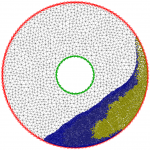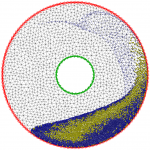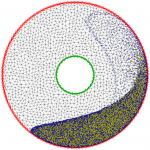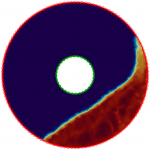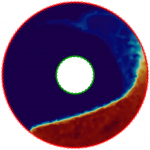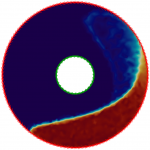Coarse Scale Model for the Fluid
Industries often requires fast software to calibrate some processes. The model we propose makes use of a representation of the fluid at a greater scale than the grain scale. The flow dynamics in the space between the grains is computed from average Navier-Stokes equations. The volume fraction of fluid is computed on control volumes, far bigger than a grain to smooth the spatial distribution of the grains, and it is used to average punctual field values to obtain a continuous representation of the mixture flow.
Motion of polydisperse grains in a circular shear flow. Upper Figures show the discrete grains, while the lower Figures show the continuous representation of the fluid volume fraction
Immersed granular flows are also encountered in geology e.g. mud volcanoes, hydrothermal vents, etc. Natural geometries in which fluid-grain mixtures flow could be just as complex as the industrial geometries in applications like gas cyclone separators, ploughshare mixers, semi-autogenous grinding mills, tower mills, etc. Finite Element Method is easily applicable to complex geometries thanks to the use of irregular grids.
The continuous representation of the mixture gives the possibility to cover the entire domain with a continuous mesh, preventing the numerical cost of a mesh reconstruction on the fluid phase at each grain displacement or the use of a penalty method. The transition between the pure fluid regime and the granular medium regime is covered by the averaging process in the modified Navier-Stokes equations. The average variables taking into account the fluid volume fraction enable a continuous transition between the two flow regimes.
